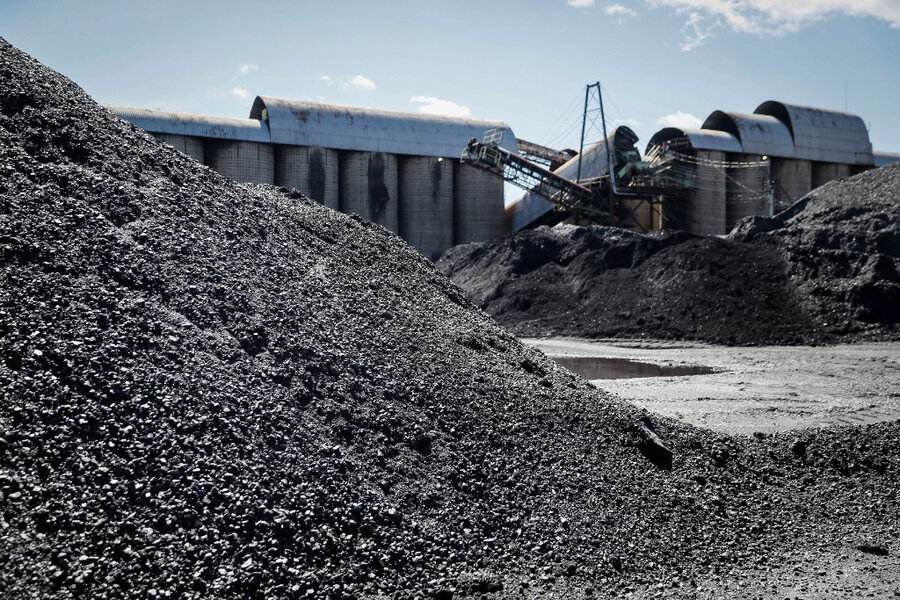US coal consumption is still dropping. How could a call to bring coal back work?
Loading...
Coal consumption in the United States dropped by 9 percent last year as America shifted its energy use toward natural gas and clean energy.
Energy consumption in the US continues to rise but its sourcing is changing, says a report released by the US Energy Information Administration last week. Fossil fuels remain the dominant source of energy in the country, still making up 81 percent of nationwide energy use. Renewables, petroleum, natural gas, and nuclear fuel have all picked up as coal consumption declined for a third year in a row.
The 2016 shift is part of a slow, ongoing decline in fossil fuels (which stood at 86 percent of US energy use in 2005), rooted in rising efficiency and competitive pricing among various types of energy.
And it comes as President Trump, who won the 2016 election in part by garnering support in places where jobs in the coal industry once brought middle-class lifestyles to workers without college degrees, promises to revive the industry and create new jobs. Democrats and environmentalists, on the other hand, have pushed for training in new sectors and emphasized the benefits of clean, renewable sources.
While changing trends might make the idea of a full revival out of reach, that doesn’t mean forays into coal are a wash.
“We’re not going to see a dramatic recovery in coal jobs, because the industry has become very efficient and highly automated, so you don’t need as many coal miners to produce a ton of coal as you did a decade ago,” Bernard Weinstein, associate director of the Maguire Energy Institute at Southern Methodist University in Dallas, tells The Christian Science Monitor in a phone interview. “In terms of keeping the coal industry relatively healthy or at least slowing its decline, I believe the real opportunity is in exports.”
That would require the construction of international coal exporting facilities, which several companies have spent the better part of the past decade trying to establish. Often met with opposition from local residents and environmental groups, the efforts have stalled, but could see some success with the support of Mr. Trump, Dr. Weinstein says.
Domestically in 2016, petroleum consumption increased because of higher demand in transportation, while natural gas was used at increasing rates in the electric power and industrial sectors, the report notes. Coal dropped in use in both the electric power and industrial coal sectors.
And that decrease in domestic consumption is to be expected, Weinstein says. But it doesn’t have to facilitate a steady hit to economies dependent on coal.
“While coal use for power generation will likely continue to decline in the US, foreign use of coal is going to continue to grow at least until the year 2030, or 2035,” he predicted, noting that fast-growing countries such as China will continue to rely on coal. Studies have shown that coal is likely to remain the second-largest energy source worldwide in coming years, and that international consumption continues to climb annually.
Still, a significant revival of communities long dependent on coal isn’t likely to come from the energy source alone, and coal-mining communities are coming to that realization. As The Christian Science Monitor’s Zack Colman reported in a cover story this month, some communities, like towns in Kentucky that once thrived under coal, are trying to leave behind the lure of the mines for new avenues. Here, younger residents care less about the singular coal industry, and more about the goal of diverse and stable jobs in various sectors within their communities.
“Perhaps more important, young residents .... have one advantage over generations past: They’re growing up without the deep-rooted loyalty to coal mining that their parents and grandparents harbored. As his classmates scale ladders around the tiny house, or slide underneath it on wheeled carts to install plumbing and insulation, they are looking to a different future.
The old mind-set that the region needs a big jobs provider – like coal – is hard to break. Younger generations watch their parents endure unsteady employment and worry about their own prospects. Older generations can’t visualize a different way forward.
One mistake outsiders make, many here say, is thinking all this is actually about coal. It’s not. It’s more about the life coal provided. Where else could you earn $80,000 a year with a high school education or less?..."
“Transitioning is tough,” says Jim Ward, the judge-executive for Letcher County, in which Whitesburg is located. “We’ve just got to figure out how to do it. And we’re just at the beginning of it.”






